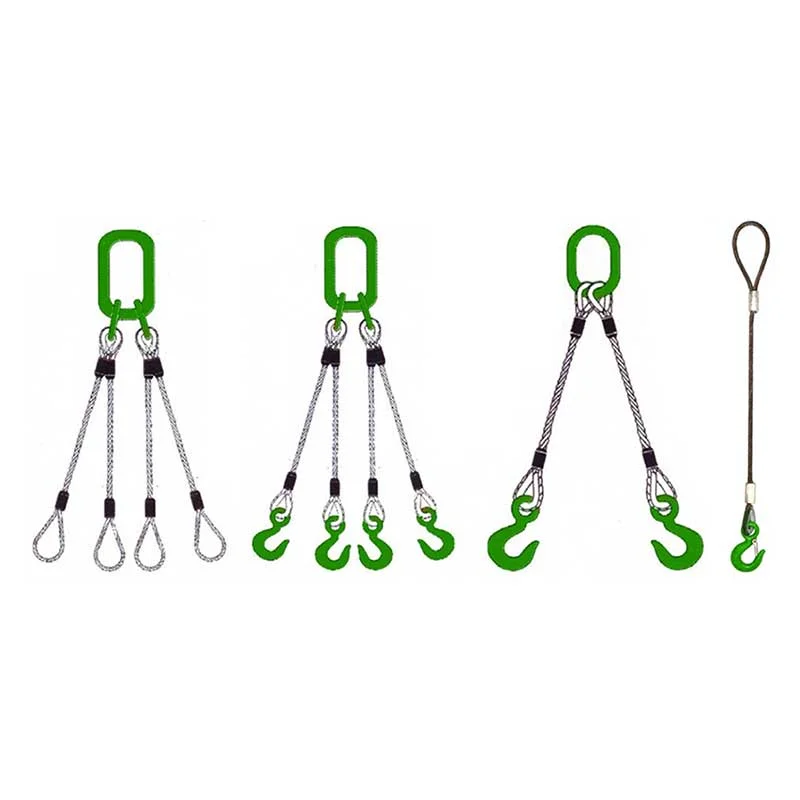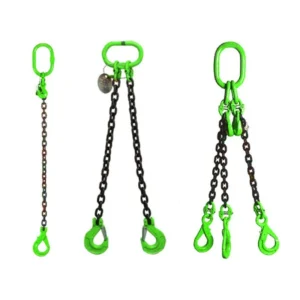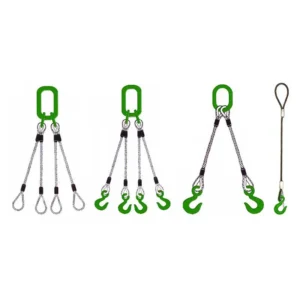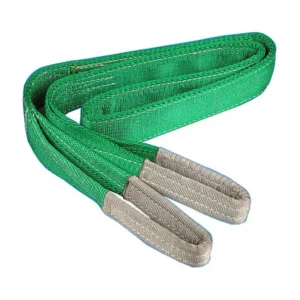Introduction
When it comes to lifting heavy loads or securing items in place, slings are indispensable tools. From Grade 80 Chain Slings to Nylon Slings, each type serves a unique purpose. In this guide, we’ll delve into the different types of slings, how to choose the right one for your needs, safety tips, techniques, occasions for sling use, maintenance, accessories, and more. Let’s explore the world of slings together.
Different Types of Slings
Grade 80 Chain Slings
GET IT NOW
Grade 80 Chain Slings are designed for heavy-duty lifting applications where precision and reliability are paramount. Constructed from high-quality alloy steel, these slings offer exceptional strength and durability, capable of handling heavy loads with ease. The Grade 80 designation indicates that the chains meet stringent quality standards, ensuring their reliability and performance in demanding industrial environments. These slings are commonly used in industries such as construction, manufacturing, and rigging, where robust lifting equipment is essential for safe and efficient operations.
Steel Wire Rope Slings
GET IT NOW
Steel Wire Rope Slings are renowned for their toughness and durability, making them ideal for demanding lifting tasks. These slings are constructed from high-strength steel wire strands woven together to form a flexible and robust lifting solution. They are capable of withstanding heavy loads and harsh environmental conditions, making them suitable for use in industries such as construction, shipping, and mining. Steel wire rope slings offer excellent resistance to abrasion, corrosion, and fatigue, ensuring long-term reliability and safety in lifting operations.
Round Slings
GET IT NOW
Round Slings are known for their flexibility, lightweight design, and gentle handling of loads. These slings are made from durable synthetic materials such as polyester, which provides excellent strength and flexibility while minimizing the risk of damage to delicate or sensitive loads. Round slings distribute the load evenly across the surface, reducing pressure points and minimizing the risk of damage during lifting operations. They are commonly used in industries such as warehousing, transportation, and manufacturing, where versatility and load protection are essential.
Nylon Sling
GET IT NOW
Nylon slings are versatile lifting tools known for their strength and adaptability to various applications. These slings are made from durable nylon webbing, offering excellent resistance to abrasion, stretching, and UV exposure. Nylon slings are lightweight and easy to handle, making them ideal for a wide range of lifting tasks in industries such as construction, logistics, and material handling. They provide a reliable and cost-effective solution for lifting loads of different shapes and sizes, offering versatility and performance in diverse work environments.
How to Choose the Right Sling for Your Needs
Choosing the right sling is crucial for safe and efficient lifting operations. Here’s a detailed guide to help you navigate through the selection process:
1. Understanding Load Requirements
Before selecting a sling, it’s essential to assess the load you’ll be lifting. Consider factors such as weight, shape, size, and center of gravity. Knowing the load requirements will help determine the type and capacity of the sling needed for the task.
2. Sling Materials
Slings are available in various materials, each offering unique properties suited for different applications. Common materials include:
- Steel: Offers exceptional strength and durability, ideal for heavy-duty lifting tasks.
- Synthetic fibers (such as nylon, polyester, and polypropylene): Lightweight, flexible, and resistant to abrasion, making them suitable for a wide range of lifting applications.
- Wire rope: Tough and durable, capable of withstanding harsh environmental conditions and heavy loads.
3. Configurations
Slings come in different configurations to accommodate various lifting scenarios. Common configurations include:
- Single-leg slings: Suitable for vertical lifting of loads with a single attachment point.
- Double-leg slings: Used for lifting heavier loads or where additional stability is required.
- Basket slings: Provide support under the load and are ideal for lifting bulky or irregularly shaped objects.
4. Safety Factors
Safety should be a top priority when selecting a sling. Consider factors such as:
- Working load limit (WLL): The maximum weight a sling can safely lift without risk of failure. Ensure the WLL of the chosen sling exceeds the weight of the load being lifted.
- Environmental conditions: Consider factors such as temperature, moisture, and exposure to chemicals or UV radiation, which may affect the performance and lifespan of the sling.
- Compliance with regulations: Ensure that the selected sling complies with relevant safety standards and regulations, such as OSHA (Occupational Safety and Health Administration) or ASME (American Society of Mechanical Engineers) standards.
By understanding the load requirements, sling materials, configurations, and safety factors, you can make an informed decision and choose the right sling for your lifting needs. Prioritizing safety and selecting the appropriate sling will help ensure the success and efficiency of your lifting operations while minimizing the risk of accidents or injuries.
Proper Usage and Safety Tips for Using Slings
Proper usage of slings is essential to ensure the safety of lifting operations and to prevent accidents or injuries. Here are some detailed guidelines for safe lifting practices, load inspection, and avoiding common mistakes:
1. Safe Lifting Practices
- Before lifting, ensure that the load is properly secured and balanced to prevent shifting during lifting operations.
- Use appropriate lifting equipment, such as slings, shackles, and hooks, rated for the intended load capacity.
- Inspect the lifting area for obstacles, overhead obstructions, and other hazards that may interfere with the lifting operation.
- Communicate effectively with the lifting team to coordinate movements and ensure everyone is aware of their roles and responsibilities.
- Lift and lower loads smoothly and evenly to prevent sudden movements that could destabilize the load or cause slippage.
2. Load Inspection
- Before using a sling, inspect it thoroughly for signs of damage, such as cuts, tears, fraying, or broken stitching.
- Check for wear or abrasion on the sling surface, particularly at contact points with the load or lifting equipment.
- Verify that all attachments, such as hooks, shackles, or eyes, are securely attached and free from defects.
- Ensure that the sling is free from knots, twists, or other deformities that could compromise its strength or integrity.
3. Avoiding Common Mistakes
- Avoid overloading the sling beyond its rated capacity, as this can lead to sling failure and pose a significant safety risk.
- Do not use damaged or worn slings, as they may fail under load and cause accidents or injuries.
- Avoid sudden movements or jerks during lifting and lowering operations, as these can cause shock loading and increase the risk of sling failure.
- Do not drag or drag loads across rough surfaces using slings, as this can cause abrasion and damage to the sling material.
- Never stand or work under a suspended load, as this poses a serious risk of injury in the event of a sling failure or load shift.
Mastering Different Sling Techniques
Mastering different sling techniques is crucial for efficient and safe lifting and rigging operations. Let’s explore the techniques associated with each type of sling:
1. Grade 80 Chain Slings
Basket Hitch: This technique involves passing the sling around the load and attaching both ends to the lifting hook, creating a basket-like configuration. It provides stability and support for loads with irregular shapes.
Choker Hitch: In this technique, the sling is passed around the load and fed through a metal link or hook to create a tight loop. It is suitable for lifting cylindrical objects such as pipes or poles.
Vertical Hitch: The sling is attached directly to the lifting hook or hardware and used to lift the load vertically. It is a straightforward and commonly used technique for lifting various types of loads.
2. Steel Wire Rope Slings
Single Leg Vertical Hitch: This technique involves attaching one end of the wire rope sling to the lifting hook and using the other end to lift the load vertically. It is suitable for lifting heavy loads with a single attachment point.
Double Leg Basket Hitch: In this technique, operators attach two wire rope slings to the lifting hook and use them to lift the load in a basket-like configuration, providing stability and support for large or bulky loads.
Bridle Hitch: Two or more wire rope slings are attached to the lifting hook and used to lift the load from multiple attachment points. It distributes the load evenly and prevents damage to the load.
3. Round Slings
Vertical Hitch: The round sling is attached directly to the lifting hook or hardware and used to lift the load vertically. It offers flexibility and adapts to the shape of the load, minimizing pressure points and reducing the risk of damage.
Choker Hitch: The round sling is passed around the load and fed through a metal link or hook to create a tight loop. It is suitable for lifting cylindrical objects or loads with limited attachment points.
Basket Hitch: The round sling is wrapped around the load and attached to the lifting hook at both ends, creating a basket-like configuration. It provides stability and support for irregularly shaped loads.
4. Nylon Slings
Vertical Hitch: Similar to other slings, the nylon sling is attached directly to the lifting hook or hardware and used to lift the load vertically.
Choker Hitch:Passing the nylon sling around the load and feeding it through a metal link or hook creates a tight loop, suitable for lifting cylindrical objects or loads with limited attachment points.
Basket Hitch: Operators wrap the nylon sling around the load and attach it to the lifting hook at both ends, providing stability and support for irregularly shaped loads.
Cleaning and Maintenance of Slings
1. Regular Inspection
- Before and after each use, inspect slings for signs of damage, wear, or deterioration. Look for cuts, tears, fraying, broken stitches, or distortion of hardware.
- Pay attention to areas where slings may come into contact with sharp edges, corners, or abrasive surfaces, as these areas are prone to wear and damage.
2. Cleaning
- Clean slings regularly to remove dirt, debris, grease, or other contaminants that may accumulate during use.
- Use mild soap and water solution to clean slings, and avoid using harsh chemicals or solvents that could degrade the sling material.
- Rinse slings thoroughly with clean water and allow them to air dry completely before storage.
3. Storage
- Store slings in a clean, dry, and well-ventilated area away from direct sunlight, heat sources, moisture, and chemicals.
- Hang slings on racks or hooks to prevent them from coming into contact with the ground or other surfaces that could cause damage.
- Avoid storing slings in tightly coiled or twisted configurations, as this can cause permanent deformation or damage to the sling material.
4. Protection from Environmental Factors
- Protect slings from exposure to extreme temperatures, UV radiation, moisture, chemicals, and other environmental factors that could degrade the sling material.
- Use protective sleeves or covers to shield slings from abrasion, cuts, and damage during use and storage.
5. Repairs and Replacements
- Repair or replace damaged or worn slings promptly to prevent accidents or injuries during lifting operations.
- Trained personnel should follow manufacturer recommendations for repairs or replacements, ensuring the use of compatible materials and techniques during the repair process.
6. Documentation and Record-Keeping
- Maintain detailed records of sling inspections, cleaning, maintenance, repairs, and replacements.
- Keep track of sling usage, load capacities, and service life to ensure compliance with safety regulations and industry standards.
Sling Accessories and Additional Features to Consider
Certainly, let’s delve into the sling accessories and additional features specific to each type of sling mentioned earlier:
1. Grade 80 Chain Slings
Chain Shorteners: These accessories allow for easy adjustment of the sling length, providing versatility in lifting operations and ensuring a secure fit around the load.
Master Links: Master links serve as central connecting points for the chain sling legs, offering added strength and durability while simplifying attachment to lifting equipment.
Chain Hooks: Equipped with safety latches or locking mechanisms, chain hooks provide secure attachment to the load and prevent accidental disengagement during lifting.
Chain Tags: Tags affixed to the chain links display essential information such as load capacity, chain grade, and inspection records, facilitating proper identification and compliance with safety standards.
2. Steel Wire Rope Slings
Wire Rope Thimbles: Thimbles protect wire rope slings from wear and deformation at connection points, extending their lifespan and ensuring safe and secure lifting.
Flemish Eye Splice: This splice configuration increases the strength and durability of wire rope slings, providing enhanced reliability and safety during lifting operations.
Wire Rope Clips: Used to create eye terminations in wire rope slings, clips secure the rope ends and prevent unraveling, ensuring a strong and stable connection to lifting equipment.
Wire Rope Sleeves: Sleeves protect wire rope slings from abrasion, cuts, and damage, particularly at connection points or areas of high stress, improving longevity and safety.
3. Round Slings
Wear Pads: Wear pads placed between the sling and the load protect round slings from abrasion and damage, ensuring longevity and maintaining load stability during lifting.
Color-Coding: Round slings may feature color-coded sleeves to indicate their rated capacity, thereby making it easy for operators to select the appropriate sling for the load and minimize the risk of overloading.
Labeling: Clear labeling on round slings provides essential information such as sling type, working load limit, and inspection dates, facilitating proper identification and compliance with safety regulations.
4. Nylon Slings
Reinforced Eyes: Nylon slings may feature reinforced eyes for added strength and durability, ensuring secure attachment to lifting equipment and minimizing the risk of sling failure.
Rubberized Coating: Some nylon slings come with a rubberized coating for improved grip and stability when lifting smooth or slippery loads, enhancing safety and load control.
Flat Eye Design: Flat eye nylon slings conform closely to the load’s surface, distributing pressure evenly and reducing the risk of damage, particularly on delicate or sensitive materials.
In conclusion, selecting the right sling, practicing safe usage, and maintaining equipment are paramount for ensuring optimal performance and safety in lifting operations. Here’s a detailed explanation of the importance of these aspects:
1. Choosing the Right Sling
-
- Selecting the appropriate sling is essential to ensure that it meets the specific requirements of the lifting task at hand.
- Selecting a sling with the correct capacity, material, configuration, and features is crucial; it ensures that it can safely and efficiently lift the intended load.
- By choosing the right sling, operators can minimize the risk of overloading, equipment damage, and accidents, while maximizing efficiency and productivity.
2. Practicing Safe Usage
-
-
- Following safe lifting practices and diligently adhering to proper rigging procedures are crucial steps for preventing accidents, injuries, and damage to property.
- To ensure safe and effective sling usage, it is imperative that operators undergo training in proper lifting techniques, load securement, and equipment inspection.
- Adhering diligently to safety regulations and industry standards helps mitigate risks and ensures compliance with legal requirements. Additionally, it promotes a culture of safety in the workplace, fostering a secure and productive environment for all personnel.
-
3. Maintaining Equipment:
-
-
-
- Regular inspection, cleaning, and maintenance of slings are essential tasks that contribute to prolonging their lifespan, ensuring reliability, and preventing premature failure. Consequently, these practices are integral to the overall safety and efficiency of lifting operations.
- Proper storage, handling, and protection from environmental factors are crucial aspects that help preserve the integrity of slings and prevent damage or degradation. Consequently, this ensures the longevity and effectiveness of the equipment..
- Prompt repairs or replacements of damaged or worn slings are necessary; consequently, this helps prevent accidents and ensures the continued safety and efficiency of lifting operations.
-
-
Operators cannot overstate the importance of choosing the right sling, practicing safe usage, and maintaining equipment. Furthermore, these factors are critical for ensuring optimal performance, preventing accidents and injuries, and promoting a safe working environment. By prioritizing safety and adhering to proper procedures, operators can effectively mitigate risks and ensure the success and efficiency of lifting operations.
For further insights or to discuss your unique requirements, we invite you to connect with us Explore the unparalleled expertise and quality solutions that Shabbir Enterprises brings to the table, ensuring your material handling equipment’s needs are met with precision and reliability.
You can also explore:
Tarpaulin: Guide to How to Choose, Use, and Maintain
Forklift Drum Grabber Double: A Guide to Warehouse Optimization
Hardware and Building Material Industry Strategies for Success




